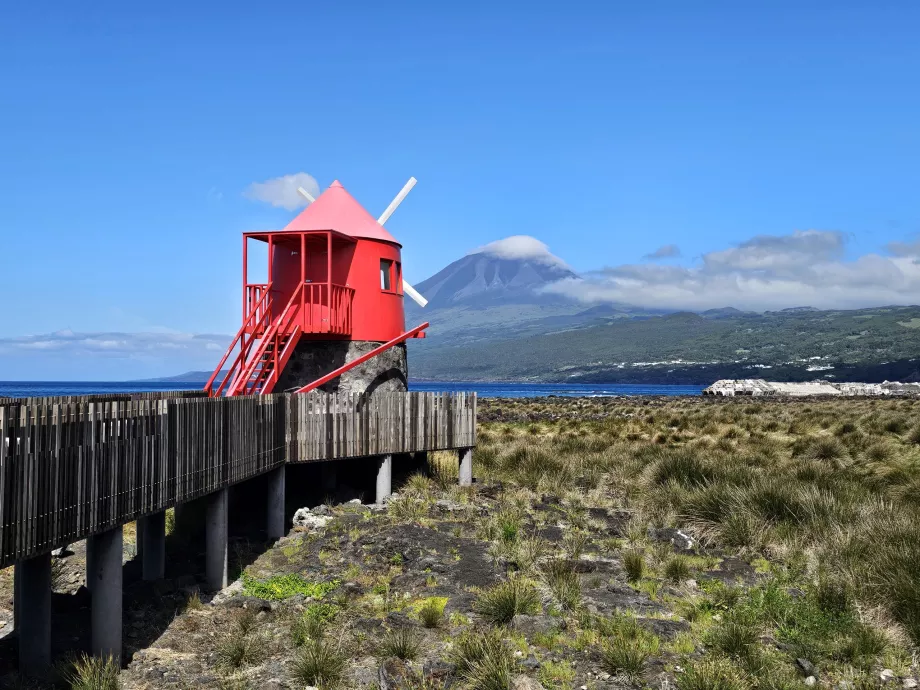Weather in Pico and best time to go

The official definition of Pico Island's climate is a humid oceanic subtropical belt. However, the weather more often resembles more of a temperate belt with the only difference being that Pico lacks the classic winter season.
In general, temperatures vary little across the year. They are highest in summer, when they rise to an average of 22 °C, and lowest in winter, when they hover around 14 °C.
The weather is very rainy and windy throughout the year. On average, measurable precipitation falls 240 days a year, but often it is just showers, with alternating rain and clear skies. Detailed conditions are described later in this chapter.
Buy tickets to Pico PIX Airport
Due to the very rugged coastline, hilly terrain and many valleys, the actual weather is very variable in different parts of the island. While the coasts are more often clear with no rain (depending on where the wind is blowing from, either on the north or south coast), the mountainous interior is always more likely to receive precipitation.
High mountain weather
Pico is the most mountainous island in the Azores, with Portugal's highest mountain reaching over 2,300 metres.
The rest of the interior is also filled with mountain ranges with heights of up to over 1 000 metres.
As elsewhere in the world, the weather in the mountains is characterised by rapid and frequent changes. Especially on the highest mountain, Pico, the weather can change several times an hour from clear skies to completely overcast, dense fog, rain or very strong winds.
In the central mountains around Caminho das Lagoas, expect permanent fog or clouds. Good weather is rare in the middle of the island, but usually you can just cross to either the south or north coast and find yourself under the sun.
The average temperature at around 1,000 metres is about 3 degrees lower than on the coast and up to 10 degrees lower above 2,000 metres.
Weather and temperatures during the year
This is how the weather on Pico looks during the different months of the year.
Compare Pico Airport car rental prices
Weather in January
January is a rainy month. It rains an average of 20 days out of the month and sometimes there can be all-day clouds with rain or fog, especially in the mountainous area.
Normal daytime temperatures soar to 14°C (57°F) and the wet climate often makes hiking trails muddy and slippery. January is therefore ideal, especially for road-trips and shorter walks around villages.
Temperatures can drop below 10 °C at night.
There may be a light snow cover on the top of Pico during January.
Weather in February
February is also a rainy month and it rains an average of 20 days a month. Rainfall is usually in the form of showers, but full days of no sun at all are not uncommon, especially in the interior.
On the coast there is a greater chance of good weather, but this is often offset by very strong winds.
Daytime temperatures are around 14 °C.
Even during February, snow can occur on the highest parts of Mount Pico.
Weather in March
The weather in March is slightly better than in winter. The rain is less intense, but you can still expect precipitation every day. However, cloudy weather often alternates with partly cloudy weather.
Expect temperatures of around 14 to 15 °C during the day and frequent very windy conditions.
Statistically, the most flights are cancelled during March due to wind.
Weather in April
During April, the weather continues to improve and expect rain on an average of 17 days a month. However, all-day rainfall is exceptional. It usually only rains for a few hours at most and then strong winds chase the clouds away.
Temperatures are around 14 °C to 16 °C, but can rise to 20 °C in the sunshine.
Weather in May
May is a typical spring month when nature is in full bloom on Pico. The rich green colour of the pastures and forests is present even in winter, but in May the hydrangeas along the paths and the flowers in the gardens also start to bloom.
Rain mostly in the form of showers on an average of 18 days during the month and all-day overcast skies are infrequent. Temperatures are around 17 °C.
Weather in June
June is a great month for travel. Rainfall continues to decrease, but you should always bear in mind that you can get wet anytime and anywhere. Showers can appear unexpectedly from clear skies.
However, it generally rains about half as much as in winter and there are partly cloudy skies most of the day.
Daytime temperatures reach 19 to 21 °C.
Weather in July
July is the rainiest month of the year. Showers usually only occur for a few tens of minutes on an average of 12 days a month, but usually it does not rain all over the island, but only in specific locations.
Warm up with temperatures between 21 and 24°C.
Weather in August
August is the hottest month of the year and similarly not as rainy as July. However, because showers fall frequently, the landscape is always beautifully green and in bloom.
Average temperatures soar to between 22 and 25 °C and August is one of the least windy months.
Weather in September
The weather changes rapidly during September. The stronger winds bring more rainfall than in summer, but the totals and frequency are not enough to deter you from going to Pico.
Rain is usually followed by long hours of partly cloudy weather, and hiking trails throughout the island are usually passable without much difficulty. Expect normal temperatures to be around 21°C.
Weather in October
Autumn on Pico means more frequent showers, more windy weather and temperatures dropping to an average of 18°C.
Despite this, October is a good month to travel, where hiking in good weather can be combined with car rides in the rain.
Weather in November
November's weather is virtually identical to October's. It rains very often, but prolonged all-day showers are not common. The wind usually drives the showers away within a few hours and semi-cloudy weather follows.
However, the temperature drops noticeably to an average of 15 to 16 °C.
Weather in December
December is the rainiest month of the year, with an average of 24 days of rain per month. Brief showers interspersed with partly cloudy weather are more common, but there can also be all-day showers with overcast skies.
Most of the time, however, you can travel to the other end of the island and find rain-free areas, at least along the coast. It can even snow on the top of Pico Mountain.
Temperatures are mostly around 14°C, but at night it can be below 10°C.
Sea temperature
The Atlantic Ocean is relatively cold all year round.
During the winter, the water temperature is between 14 and 16 °C and rises to a maximum of 20 °C in the summer.
Table of temperatures during the year
Pico - Temperatures during the year
When to go to Pico
Pico is a year-round destination, especially for residents of Europe and North America. Although even Pico has worse weather in the winter than in the summer, it is significantly better and warmer compared to continental Europe or Canada and the northern US.
Even during winter, Pico remains a green destination. Many of the trees are coniferous and therefore do not fall over for the winter, and the grass in the ubiquitous pastures also thrives all year round.
However, your best chance of weather is between May and September, when it's high season. During this period, we recommend booking accommodation and other services more than 4 months in advance due to limited capacity.
Book your accommodation in advance
Hiking in the mountains
If your goal on Pico Island is to climb Portugal's highest mountain, Pico, plan your trip ideally between April and October.
This is when there is the best chance of good, snow-free weather.
While snow is not entirely common even at the highest elevations, if it does fall, Mount Pico is usually closed to the public entirely.
The main climbing season, when the peak can be climbed 24/7, is from June to September.
Any questions left?
If you have any questions or comments about the article...

